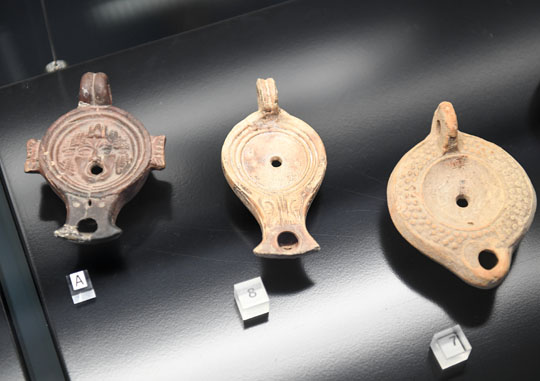Shining bright
Freiburg, Feb 28, 2018
Objects from days gone by often find their way into the University of Freiburg's Archaeological Collection as gifts. Frequently, the donated pieces are valuable. The most weird and wonderful new acquisitions are now being presented in a series. Among these are a collection of 110 oil lamps that demonstrate the diversity of everyday objects in ancient times.
 The lamp on the left depicts a mask of the type actors wore in the theaters in ancient times. Oil was put in via the mouth.
The lamp on the left depicts a mask of the type actors wore in the theaters in ancient times. Oil was put in via the mouth.
Photo: Patrick Seeger
The delicate, little oil lamp has its mouth open wide — or at least the male face on the discus does. The discus is the plate used to close the top of the vessel. There's a large, round hole in place of the man's mouth. The hole was there to allow the lamp to be refilled with oil. The image was inspired by a theatrical mask, the kind that actors often wore over their faces in ancient times. In this case, it's the mask of a tragedian, who has opened his mouth to scream.
The piece is one of about 110 ancient oil lamps donated to the Archaeological Collection of the University of Freiburg by Dietrich Schmitt of Ebnet. He acquired the lamps during the course of his life and before he died, set out that they should come into the possession of the Archaeological Collection," explains the collection's curator, Dr. Jens-Arne Dickmann. "The special thing about this collection is that it is exclusively made up of complete or nearly intact oil lamps," he continues.
Schmitt obtained all the lamps from art dealers. About three dozen of them have been on display in a showcase of the Archaeological Collection since 2014. They cover a time period of nearly 1500 years – from the 8th century BC to the 8th century AD. The oldest items on display were cut from stone. Later pieces are made of clay.
Alternative fuels
Egyptian matrix technology wasn't adopted in Rome or the Hellenistic areas until the 3rd century BC, after which oil lamps became affordable, mass-produced goods. Presumably the Roman style of lamp, with a decorated discus or mirror, became prevalent during the Augustan period. It spread as far as the Germanic and Celtic areas of settlement. Later, in North Africa, Christian motifs were incorporated into the Roman designs.
"I'm very pleased about this donation with respect to how lamps like these were used. They raise questions about aspects of the history of daily life," says Dickmann. The curator lists the queries: How many lamps were used in one room at the same time? Which fuel was used to fill them? In places where oil was scarce, people must have burned other substances. He notes that the lamps even had to be adapted to do this in some cases. "Because of the temporal range in the selection of objects and the differences between them, they literally tell the story of and illuminate ancient lighting technology."
Hans Dieter Fronz
Archaeological Collection of the University of Freiburg

